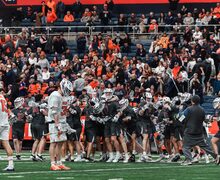Split decisions
Much has been said about lacrosse developing as a major sport in the United States, especially at the collegiate level. But Division I men’s lacrosse coaches know their sport isn’t even close to garnering the kind of respect big-time sports receive.
It’s quite simple, really, because Division I athletics comes down to one thing, and the nation’s men’s lacrosse programs don’t have it thanks to NCAA regulations – money.
NCAA rules only permit Division I men’s lacrosse teams to give out 12.6 scholarships, an amount that has decreased in the past 15 years despite increased interest in the sport. While men’s basketball or football coaches can offer about 80 percent of players on their rosters full scholarships, lacrosse coaches are forced to divide their scholarships among rosters often with more than 40 athletes.
As recently as 1992, Division I men’s lacrosse programs had 14 scholarships. The NCAA cut the limit on scholarships for most men’s sports besides basketball and football 10 percent to fund and promote more women’s athletics. This cut placed lacrosse at the 12.6 scholarships it has now.
The limited number of scholarships forces lacrosse coaches to be creative, splitting the money many ways in order to fill the needs of the athletes while still attracting top recruits to their programs.
‘You’re trying to get as much bang for your buck,’ Johns Hopkins head coach Dave Pietramala said. ‘In the sport of lacrosse, there are a number of kids who pay their own way. There’s such limited money.’
Lacrosse is at a disadvantage compared to other sports. It’s often tough to convince a recruit to play lacrosse when he’s also receiving scholarship offers for another major sport.
Virginia head coach Dom Starsia said when a recruit is also considering offers for sports like football, the odds the recruit will accept the lacrosse scholarship are slim. Football only offers full scholarships while lacrosse rarely, if never, can afford awarding a full athletic scholarship.
When an athlete has prospects at a school for lacrosse and another sport, the two coaches may also work together to coax the recruit to come to that school for the major sport, but also join the lacrosse team in the spring.
But lacrosse has an advantage compared to football or basketball. While the major sports are played universally across areas, lacrosse is mainly a suburban sport, Starsia said. That means while some football or basketball recruits could not afford college without scholarships, lacrosse athletes generally have the means to pay for college with little or no help from the university.
‘Lacrosse is a suburban sport,’ Starsia said. ‘Families can generally afford it. If you took away lacrosse, you still have to go to college. They’d probably end up looking at the same schools anyway.’
While that’s the case for some families, athletes who fall into the middle-class category often take the brunt of the burden. It’s these athletes who qualify for little financial aid, can’t afford full tuition and need some type of scholarship to help offset the cost.
‘For a family that’s right in the middle, they still have to come up with a decent amount of money,’ Pietramala said. ‘That’s why you try to spread your scholarships around. Help as many people as you can. There’s just not enough to go around.’
Coaches use the quality of education as a selling point for recruits, since the prospects to make a living playing professional lacrosse are slim. Schools that appear perennially in the top of lacrosse rankings also tend to be top-ranked institutions. Four teams in the 2006 preseason top 10 are also ranked in the top 15 universities by U.S. News and World Report.
Due to tuition costs, coaches also take advantage of any academic or need-based money their athletes may receive. After gauging the level of money each of the athletes has, coaches can fill in gaps in aid by using fractions of scholarships.
Ivy League schools, like Cornell and Princeton, do not have any athletic scholarships, so athletes must either pay full tuition or qualify for need-based grants. Despite the perceived disadvantage to schools who offer athletic scholarships, both are ranked in the top 10 this season.
‘People talk about how hard it’s for us,’ Princeton head coach Bill Tierney said. ‘We don’t look at it that way. We have the opportunity to recruit some very bright athletes. We have no limitations on financial aid. We could financially aid all of them if they qualified. We’ve found a way to offset (the absence of scholarships) due to the value of a Princeton education. I used to bemoan it, but now I look at the glass half full.’
Schools that have athletic scholarships may be more burdened than Ivy League schools that, despite the absence of athletic scholarships, make up for athletic scholarships with large endowments to fund grants.
And with lacrosse moving toward a recruiting model like basketball – where recruits commit as early as junior year of high school – coaches need to be more aggressive in recruiting while remaining cognizant of the limitations on scholarships.
The number of scholarships isn’t likely to increase soon due to the already high expense of running an athletic department with many non-revenue sports.
With 12.6 scholarships, coaches are forced to keep their focus on the needs of athletes already on the team while accurately evaluating recruits to see if they are worthy of receiving a piece of the limited resources.
‘NCAA-wise, you’re allowed 12.6 and here we are with a 50-man roster,’ Syracuse head coach John Desko said. ‘You can’t really make any mistakes with your scholarships, and we have to split them up and get the most mileage that we can.’
Published on February 21, 2006 at 12:00 pm





